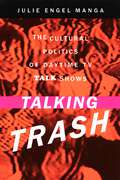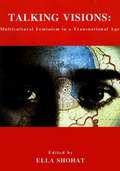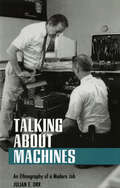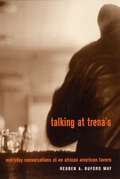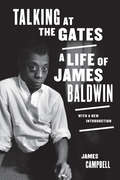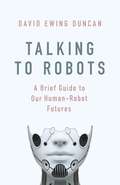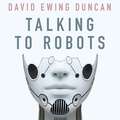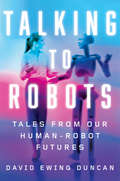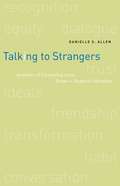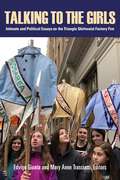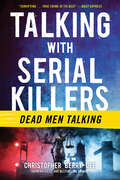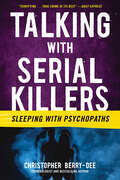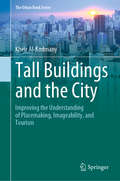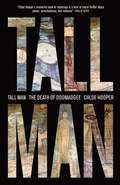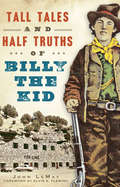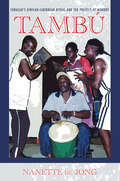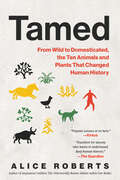- Table View
- List View
Talking To The Ground
by Douglas PrestonIn 1992 author Douglas Preston and his wife and daughter rode horseback across 400 miles of desert in Utah, Arizona, and New Mexico. They were retracing the route of a Navajo deity, the Slayer of Alien Gods, on his quest to restore beauty and balance to the Earth. More than a travelogue, Preston’s account of their “one tough journey, luminously remembered” (Kirkus Reviews) is a tale of two cultures meeting in a sacred land and is “like traveling across unknown territory with Lewis and Clark to the Pacific” (Dee Brown, author of Bury My Heart At Wounded Knee).
Talking Trash: The Cultural Politics of Daytime TV Talk Shows
by Julie MangaWhen The Phil Donahue Show topped the ratings in 1979, it ushered in a new era in daytime television. Mixing controversial social issues, light topics, and audience participation, it created a new genre, one that is still flourishing, despite being harshly criticized, over two decades later. Now, the daytime TV landscape is littered with talk shows. But why do people watch these shows? How do they make sense of them? And how do these shows affect their viewers' sense of what constitutes appropriate public debate? In Talking Trash, Julie Engel Manga offers a fascinating exploration of these questions and reveals the wide range of reasons viewers are drawn to “trash talk.” Focusing on such shows as Oprah!, Jerry Springer, Ricki Lake, Jenny Jones, and Maury Povitch, and drawing upon interviews with women who watch these shows, Talking Trash is the first examination of the talk show phenomenon from the viewers’ perspective. In taking this approach, Manga is able to understand what talk shows mean to the women who watch them. And by refusing to judge either the shows or their viewers as good or bad, she is able to grasp how viewers relate to these shows-as escape, entertainment, uninhibited public discourse, or an accurate reflection of their own hardships and heartaches. Manga concludes that while the form of “trash-talk” shows may be relatively new, the socio-cultural experience they embody has been with us for a long time. Absorbing, entertaining, and keenly perceptive, Talking Trash illuminates the complex viewer response to “trash talk” and examines the cultural politics surrounding this wildly controversial popular phenomenon.
Talking about Machines: An Ethnography of a Modern Job
by Julian E. OrrThis is a story of how work gets done. It is also a study of how field service technicians talk about their work and how that talk is instrumental in their success. In his innovative ethnography, Julian E. Orr studies the people who repair photocopiers and shares vignettes from their daily lives. He characterizes their work as a continuous highly skilled improvisation within a triangular relationship of technician, customer, and machine. The work technicians do encompasses elements not contained in the official definition of the job yet vital to its success. Orr's analysis of the way repair people talk about their work reveals that talk is, in fact, a crucial dimension of their practice. Diagnosis happens through a narrative process, the creation of a coherent description of the troubled machine. The descriptions become the basis for technicians' discourse about their experience, and the circulation of stories among the technicians is the principal means by which they stay informed of the developing subtleties of machine behavior. Orr demonstrates that technical knowledge is a socially distributed resource stored and diffused primarily through an oral culture. Based on participant observation with copier repair technicians in the field and strengthened by Orr's own years as a technician, this book explodes numerous myths about technicians and suggests how technical work differs from other kinds of employment.
Talking at Trena's: Everyday Conversations at an African American Tavern
by Reuben A. MayTalking at Trena's is an ethnography conducted in a bar in an African American, middle-class neighborhood on Chicago's southside. May's work focuses on how the mostly black, working- and middle-class patrons of Trena's talk about race, work, class, women, relationships, the media, and life in general. May recognizes tavern talk as a form of social play and symbolic performace within the tavern, as well as an indication of the social problems African Americans confront on a daily basis. Following a long tradition of research on informal gathering places, May's work reveals, though close description and analysis of ethnographic data, how African Americans come to understand the racial dynamics of American society which impact their jobs, entertainment-particularly television programs-and their social interactions with peers, employers, and others. Talking at Trena's provides a window into the laughs, complaints, experiences, and strategies which Trena's regulars share for managing daily life outside the safety and comfort of the tavern.
Talking at the Gates: A Life of James Baldwin
by James CampbellAn intimate portrait of Baldwin's mythic life. James Baldwin was one of the most incisive and influential American writers of the twentieth century. Active in the civil rights movement and open about his homosexuality, Baldwin was celebrated for eloquent analyses of social unrest in his essays and for daring portrayals of sexuality and interracial relationships in his fiction. By the time of his death in 1987, both his fiction and nonfiction works had achieved the status of modern classics. James Campbell knew James Baldwin for the last ten years of Baldwin's life. For Talking at the Gates, Campbell interviewed many of Baldwin's friends and professional associates and examined several hundred pages of correspondence. Campbell was the first biographer to obtain access to the large file that the FBI and other agencies had compiled on the writer. Examining Baldwin's turbulent relationships with Norman Mailer, Richard Wright, Marlon Brando, Martin Luther King Jr., and others, this candid and original account portrays the life and work of a writer who held to the principle that "the unexamined life is not worth living." This new edition features a fresh introduction addressing recent developments in Baldwin’s reputation and his return to a position he occupied in the early 1960s, when Life magazine called him "the monarch of the current literary jungle." It also contains a previously unpublished interview with Norman Mailer about Baldwin, which Campbell conducted in 1987.
Talking from 9 to 5: Women and Men at Work
by Deborah Tannen“Required reading…sharp and insightful…lively and straightforward…a novel and sometimes startling analysis of workplace dynamics.”—New York Times Book ReviewIn her extraordinary international bestseller, You Just Don’t Understand, Deborah Tannen transformed forever the way we look at intimate relationships between women and men. Now she turns her keen ear and observant eye toward the workplace—where the ways in which men and women communicate can determine who gets heard, who gets ahead, and what gets done. An instant classic, Talking From 9 to 5 brilliantly explains women’s and men’s conversational rituals—and the language barriers we unintentionally erect in the business world. It is a unique and invaluable guide to recognizing the verbal power games and miscommunications that cause good work to be underappreciated or go unnoticed—an essential tool for promoting more positive and productive professional relationships among men and women.
Talking of the Royal Family
by Michael Billig Prof Michael BilligTo talk about royalty is to talk of many things: privilege, equality, nationality, morality, family life, parenting, divorce, the media and more. Important themes and issues flow through the seemingly trivial everyday chatter about royalty.Now with a new preface, Talking of the Royal Family was the first serious full-length study of royalty to emerge from this rhetorical perspective and remains relevant today.
Talking on the Water: Conversations about Nature and Creativity
by Jonathan WhiteDuring the 1980s and 1990s, the Resource Institute, headed by Jonathan White, held a series of "floating seminars" aboard a sixty-five-foot schooner featuring leading thinkers and artists from a broad array of disciplines. Over a period of ten years, White conducted interviews with the writers, scientists, environmentalists, and poets who gathered on board to explore our relationship to the wild. The interviews are gathered in this sparkling collection. Some of these visionaries are still making history, while others have passed away, making this legacy especially vital to the narrative about our planet.White describes the conversations in Talking on the Water as the "roots" of an integrated community. "While at first these roots may not appear to be linked, a closer look reveals that they are sustained in common ground. Whether we are talking to a poet, a biologist, a science fiction writer, or an ex-Dominican priest, all of these people share a deep and longstanding concern for their relationship with nature."Beloved fiction writer Ursula K. Le Guin discusses the nature of language, microbiologist Lynn Margulis contemplates Darwin's career and the many meanings of evolution, and anthropologist Richard Nelson sifts through the spiritual life of Alaska's native people. Rounding out
Talking to My Daughter About the Economy: or, How Capitalism Works--and How It Fails
by Yanis Varoufakis Jacob MoeIn Talking to My Daughter About the Economy, activist Yanis Varoufakis, Greece’s former finance minister and the author of the international bestseller Adults in the Room, pens a series of letters to his young daughter, educating her about the business, politics, and corruption of world economics. Yanis Varoufakis has appeared before heads of nations, assemblies of experts, and countless students around the world. Now, he faces his most important—and difficult—audience yet. Using clear language and vivid examples, Varoufakis offers a series of letters to his young daughter about the economy: how it operates, where it came from, how it benefits some while impoverishing others. Taking bankers and politicians to task, he explains the historical origins of inequality among and within nations, questions the pervasive notion that everything has its price, and shows why economic instability is a chronic risk. Finally, he discusses the inability of market-driven policies to address the rapidly declining health of the planet his daughter’s generation stands to inherit. Throughout, Varoufakis wears his expertise lightly. He writes as a parent whose aim is to instruct his daughter on the fundamental questions of our age—and through that knowledge, to equip her against the failures and obfuscations of our current system and point the way toward a more democratic alternative.
Talking to Robots: A Brief Guide to Our Human-Robot Futures
by David Ewing DuncanOne of Time magazine's '32 Books You Need to Read This Summer' -- 'a riveting read'.'Intensely readable, downright terrifying, and surprisingly uplifting.'Vanity Fair'A fascinating work of imaginative futurology, a science journalist takes a look at our current technologies and anticipates the human-robot future that could await us - one full of warrior bots, politician bots, doctor bots and sex bots.'One of Barbara VanDenburgh's '5 Books Not to Miss', USA TodayOne of the best summer reads of 2019, according to top authors David Baldacci and Elizabeth Acevedo on USA Today's Today programme. 'A refreshing variation on the will-intelligent-robots-bring-Armageddon genre . . . this colorful mixture of expert futurology and quirky speculation does not disappoint' Kirkus ReviewsWhat robot and AI systems are being built and imagined right now? What do they say about us, their creators? Will they usher in a fantastic new future, or destroy us? What do some of our greatest thinkers, from physicist Brian Greene and futurist Kevin Kelly to inventor Dean Kamen, geneticist George Church and filmmaker Tiffany Shlain, anticipate for our human-robot future? For even as robots and AI intrigue us and make us anxious about the future, our fascination with robots has always been about more than the potential of the technology - it also concerns what robots tell us about being human.From present-day Facebook and Amazon bots to near-future 'intimacy' bots and 'the robot that swiped my job' bots, bestselling American popular science writer David Ewing Duncan's Talking to Robots is a wonderfully entertaining and insightful guide to possible future scenarios about robots, both real and imagined.Featured bots include robot drivers; doc bots; politician bots; warrior bots; sex bots; syntheticbio bots; dystopic bots that are hopefully just bad dreams; and ultimately, God Bot (asdescribed by physicist Brian Greene). These scenarios are informed by discussions with well-known thinkers, engineers, scientists, artists, philosophers and others, who share with us their ideas, hopes and fears about robots. David spoke with, among others, Kevin Kelly, David Baldacci, Brian Greene, Dean Kamen, Craig Venter, Stephanie Mehta, David Eagleman, George Poste, George Church, General R. H. Latiff, Robert Seigel, Emily Morse, David Sinclair, Ken Goldberg, Sunny Bates, Adam Gazzaley, Tim O'Reilly, Tiffany Shlain, Eric Topol and Juan Enriquez.These discussions, along with some reporting on bot-tech, bot-history and real-time societal andethical issues with robots, are the launch pads for unfurling possible bot futures that are informed by how people and societies have handled new technologies in the past.The book describes how robots work, but its primary focus is on what our fixation with botsand AI says about us as humans: about our hopes and anxieties; our myths, stories, beliefs andideas about beings both real and artificial; and our attempts to attain perfection.We are at a pivotal moment when our ancient infatuation with human-like beings with certainattributes or superpowers - in mythology, religion and storytelling - is coinciding with ourability to actually build some of these entities.
Talking to Robots: A Brief Guide to Our Human-Robot Futures
by David Ewing DuncanOne of Time magazine's '32 Books You Need to Read This Summer' -- 'a riveting read'.'Intensely readable, downright terrifying, and surprisingly uplifting.'Vanity Fair 'A fascinating work of imaginative futurology, a science journalist takes a look at our current technologies and anticipates the human-robot future that could await us - one full of warrior bots, politician bots, doctor bots and sex bots.'One of Barbara VanDenburgh's '5 Books Not to Miss', USA Today One of the best summer reads of 2019, according to top authors David Baldacci and Elizabeth Acevedo on USA Today's Today programme. 'A refreshing variation on the will-intelligent-robots-bring-Armageddon genre . . . this colorful mixture of expert futurology and quirky speculation does not disappoint' Kirkus ReviewsWhat robot and AI systems are being built and imagined right now? What do they say about us, their creators? Will they usher in a fantastic new future, or destroy us? What do some of our greatest thinkers, from physicist Brian Greene and futurist Kevin Kelly to inventor Dean Kamen, geneticist George Church and filmmaker Tiffany Shlain, anticipate for our human-robot future? For even as robots and AI intrigue us and make us anxious about the future, our fascination with robots has always been about more than the potential of the technology - it also concerns what robots tell us about being human.From present-day Facebook and Amazon bots to near-future 'intimacy' bots and 'the robot that swiped my job' bots, bestselling American popular science writer David Ewing Duncan's Talking to Robots is a wonderfully entertaining and insightful guide to possible future scenarios about robots, both real and imagined.Featured bots include robot drivers; doc bots; politician bots; warrior bots; sex bots; syntheticbio bots; dystopic bots that are hopefully just bad dreams; and ultimately, God Bot (asdescribed by physicist Brian Greene). These scenarios are informed by discussions with well-known thinkers, engineers, scientists, artists, philosophers and others, who share with us their ideas, hopes and fears about robots. David spoke with, among others, Kevin Kelly, David Baldacci, Brian Greene, Dean Kamen, Craig Venter, Stephanie Mehta, David Eagleman, George Poste, George Church, General R. H. Latiff, Robert Seigel, Emily Morse, David Sinclair, Ken Goldberg, Sunny Bates, Adam Gazzaley, Tim O'Reilly, Tiffany Shlain, Eric Topol and Juan Enriquez.These discussions, along with some reporting on bot-tech, bot-history and real-time societal andethical issues with robots, are the launch pads for unfurling possible bot futures that are informed by how people and societies have handled new technologies in the past.The book describes how robots work, but its primary focus is on what our fixation with botsand AI says about us as humans: about our hopes and anxieties; our myths, stories, beliefs andideas about beings both real and artificial; and our attempts to attain perfection.We are at a pivotal moment when our ancient infatuation with human-like beings with certainattributes or superpowers - in mythology, religion and storytelling - is coinciding with ourability to actually build some of these entities.
Talking to Robots: Tales from Our Human-Robot Futures
by David Ewing DuncanAward-winning journalist David Ewing Duncan considers 24 visions of possible human-robot futures—Incredible scenarios from Teddy Bots to Warrior Bots, and Politician Bots to Sex Bots—Grounded in real technologies and possibilities and inspired by our imagination. What robot and AI systems are being built and imagined right now? What do they say about us, their creators? Will they usher in a fantastic new future, or destroy us? What do some of our greatest thinkers, from physicist Brian Greene and futurist Kevin Kelly to inventor Dean Kamen, geneticist George Church, and filmmaker Tiffany Shlain, anticipate about our human-robot future? For even as robots and A.I. intrigue us and make us anxious about the future, our fascination with robots has always been about more than the potential of the technology–it’s also about what robots tell us about being human.
Talking to Strangers: Anxieties of Citizenship since Brown v. Board of Education
by Danielle S. Allen"Don't talk to strangers" is the advice long given to children by parents of all classes and races. Today it has blossomed into a fundamental precept of civic education, reflecting interracial distrust, personal and political alienation, and a profound suspicion of others. In this powerful and eloquent essay, Danielle Allen, a 2002 MacArthur Fellow, takes this maxim back to Little Rock, rooting out the seeds of distrust to replace them with "a citizenship of political friendship. "Returning to the landmark Brown v. Board of Education decision of 1954 and to the famous photograph of Elizabeth Eckford, one of the Little Rock Nine, being cursed by fellow "citizen" Hazel Bryan, Allen argues that we have yet to complete the transition to political friendship that this moment offered. By combining brief readings of philosophers and political theorists with personal reflections on race politics in Chicago, Allen proposes strikingly practical techniques of citizenship. These tools of political friendship, Allen contends, can help us become more trustworthy to others and overcome the fossilized distrust among us. Sacrifice is the key concept that bridges citizenship and trust, according to Allen. She uncovers the ordinary, daily sacrifices citizens make to keep democracy working and offers methods for recognizing and reciprocating those sacrifices. Trenchant, incisive, and ultimately hopeful, Talking to Strangers is nothing less than a manifesto for a revitalized democratic citizenry.
Talking to Strangers: What We Should Know about the People We Don't Know
by Malcolm GladwellMalcolm Gladwell, host of the podcast Revisionist History and author of the #1 New York Times bestseller Outliers, offers a powerful examination of our interactions with strangers--and why they often go wrong. <P><P>How did Fidel Castro fool the CIA for a generation? Why did Neville Chamberlain think he could trust Adolf Hitler? Why are campus sexual assaults on the rise? Do television sitcoms teach us something about the way we relate to each other that isn't true? <P><P>Talking to Strangers is a classically Gladwellian intellectual adventure, a challenging and controversial excursion through history, psychology, and scandals taken straight from the news. He revisits the deceptions of Bernie Madoff, the trial of Amanda Knox, the suicide of Sylvia Plath, the Jerry Sandusky pedophilia scandal at Penn State University, and the death of Sandra Bland---throwing our understanding of these and other stories into doubt. <P><P>Something is very wrong, Gladwell argues, with the tools and strategies we use to make sense of people we don't know. And because we don't know how to talk to strangers, we are inviting conflict and misunderstanding in ways that have a profound effect on our lives and our world. In his first book since his #1 bestseller, David and Goliath, Malcolm Gladwell has written a gripping guidebook for troubled times. <P><P><b>A New York Times Bestseller</b>
Talking to the Dead: Religion, Music, and Lived Memory among Gullah/Geechee Women
by LeRhonda S. Manigault-BryantTalking to the Dead is an ethnography of seven Gullah/Geechee women from the South Carolina lowcountry. These women communicate with their ancestors through dreams, prayer, and visions and traditional crafts and customs, such as storytelling, basket making, and ecstatic singing in their churches. Like other Gullah/Geechee women of the South Carolina and Georgia coasts, these women, through their active communication with the deceased, make choices and receive guidance about how to live out their faith and engage with the living. LeRhonda S. Manigault-Bryant emphasizes that this communication affirms the women's spiritual faith--which seamlessly integrates Christian and folk traditions--and reinforces their position as powerful culture keepers within Gullah/Geechee society. By looking in depth at this long-standing spiritual practice, Manigault-Bryant highlights the subversive ingenuity that lowcountry inhabitants use to thrive spiritually and to maintain a sense of continuity with the past.
Talking to the Girls: Intimate and Political Essays on the Triangle Shirtwaist Factory Fire
by Edvige Giunta and Mary Anne TrasciattiCandid and intimate accounts of the factory-worker tragedy that shaped American labor rights On March 25, 1911, a fire broke out on the eighth floor of the Asch Building in Greenwich Village, New York. The top three floors housed the Triangle Waist Company, a factory where approximately 500 workers, mostly young immigrant women and girls, labored to produce fashionable cotton blouses, known as “waists.” The fire killed 146 workers in a mere 15 minutes but pierced the perpetual conscience of citizens everywhere. The Asch Building had been considered a modern fireproof structure, but inadequate fire safety regulations left the workers inside unprotected. The tragedy of the fire, and the resulting movements for change, were pivotal in shaping workers' rights and unions. A powerful collection of diverse voices, Talking to the Girls: Intimate and Political Essays on the Triangle Fire brings together stories from writers, artists, activists, scholars, and family members of the Triangle workers. Nineteen contributors from across the globe speak of a singular event with remarkable impact. One hundred and eleven years after the tragic incident, Talking to the Girls articulates a story of contemporary global relevance and stands as an act of collective testimony: a written memorial to the Triangle victims.
Talking with Serial Killers: Dead Men Talking (Talking with Serial Killers)
by Christopher Berry-DeeA noted criminologist shares the stories of some of the world's most notorious mass murderers—death row inmates awaiting execution.For over twenty-five years, leading crime expert Christopher Berry-Dee has gained the trust of some of the most infamous convicted killers, having corresponded with them and even entered their prison lairs to discuss their horrific crimes in detail. In Talking with Serial Killers: Dead Men Talking, he presents six unforgettable prisoners and allows them to tell their stories, providing the details and background of their terrifying cases.Beyond the headlines, once the courtroom drama has subsided and the prison gates have been locked, readers can get up close and personal with torturers, sexual psychopaths, and mass murderers to read the stories that are rarely heard and get the last word from some of the world’s most pitiless killers. A must-read for true crime aficionados and anyone fascinated by the extremes of human behavior.
Talking with Serial Killers: Sleeping with Psychopaths (Talking with Serial Killers)
by Christopher Berry-DeeExclusive, first-hand accounts of the men and women who have slept with infamous killers in a book praised as “terrifying . . . true crime at its best” (Daily Express).Bestselling true crime writer and criminologist Christopher Berry-Dee turns his attention to a new kind of victim: the wives and partners of serial murderers who remained unaware of exactly who they had fallen for until after their other half’s arrest or, in some cases, conviction. Only upon Peter’s arrest did Sonia Sutcliffe first discover that her husband was leading a secret existence as the Yorkshire Ripper. The wife of the Hillside Strangler only learned of her husband’s crimes when state police smashed down her door in search of him. When finding out the truth, these innocents have to face the grim reality of betrayal and deceit and often experience guilt for not having recognized the killer in their home. Christopher Berry-Dee speaks directly with killers and their oblivious loved ones to get inside the minds of the men and women who fall for murderers.
Tall Buildings and the City: Improving the Understanding of Placemaking, Imageability, and Tourism (The Urban Book Series)
by Kheir Al-KodmanyThe chaotic proliferation of skyscrapers in many cities around the world is contributing to a decline in placemaking. This book examines the role of skyscrapers and open spaces in promoting placemaking in the city of Chicago. Chicago’s skyscrapers tell an epic story of transformative architectural design, innovative engineering solutions, and bold entrepreneurial spirit. The city’s public plazas and open spaces attract visitors, breathe life, and bring balance into the cityscape. Using locational data from social media platforms, including Twitter, Facebook, and Instagram, along with imagery from Google Earth, fieldwork, direct observations, in-depth surveys, and the combined insights from architectural and urban design literature, this study reveals the roles that socio-spatial clusters of skyscrapers, public spaces, architecture, and artwork play to enhance placemaking in Chicago. The study illustrates how Chicago, as the birthplace of skyscrapers, remains a leading city in tall building integration and innovation. Focusing on some of the finest urban places in America, including the Chicago River, the Magnificent Mile, and the Chicago Loop, the book offers meaningful architectural and urban design lessons that are transferable to emerging skyscraper cities around the globe.
Tall Man
by Chloe HooperEarly in 2005 Chloe Hooper was drawn into the bewildering and tragic case of Cameron Doomagee, an Aboriginal man on Australia's Palm Island, who died in police custody within one hour of his arrest. Like Joan Didion and Norman Mailer, Hooper brings a novelist's eye for detail and an acute understanding of character to this story. She explores the daily lives of these people, the role of the mythology and superstition, the impact of landscape, and the history of devastating repression, addiction and violence among the Aboriginal people. Hooper is brought to Palm Island by the lawyer representing Doomagee. She spends months garnering the trust of all involved. She recreates both the dramatic events of one morning and all the forces, "individual and historic" that led up to it. And then she chronicles the trial of the charismatic police Sergeant charged with manslaughter, "the first police office in Australia ever to be charged over a death in custody. This is an outstanding account of a landmark episode in Australian history, a searing story of racial conflict that will resonate with American readers.
Tall Tales & Half Truths of Pat Garrett (American Legends)
by John LeMayWhile many lionize Billy the Kid, the man who killed him, Sheriff Patrick Floyd Garrett, has a rarely told but riveting true story all his own. His adventurous life spawned many a far-fetched, exciting legend. In 1896, Garrett's investigation of the still-unsolved murder of Albert J. Fountain on the White Sands led to nothing but a gunfight and a dead deputy. Some say that Garrett faked the details the night the Kid was brought to ultimate justice, while others swear another wannabe hero did him in. In perfect irony, Garrett's own 1908 death is shrouded in mystery. Some report he died by the hand of Billy the Kid himself. Author John LeMay exposes fabricated tales for what they are and focuses on memories long forgotten about Billy the Kid's personal grave digger, Sheriff Pat Garrett.
Tall Tales and Half Truths of Billy the Kid (American Legends)
by John LeMay“A great exposé . . . that humorously captures the many myths that Americans are willing to believe and that make up the tapestry of the Old West.” —Former Representative Morgan NelsonWhile many respectable books on Billy the Kid aim to demystify his illusory life, this one-of-a-kind collection proudly has no such intention. Find all of the untold and potentially true—but very unlikely and highly embellished—stories of the Kid’s life, death and enthralling life thereafter. Be thrilled by sightings of Billy’s ghost riding through old Fort Sumner and marvel at his search for the fabled Lost Adams Diggings. Wonder at the mysterious thefts of his tombstone and discover the famed desperado’s dozen or so doppelgangers who posthumously popped up all across the Southwest. Courtesy of yarn-spinning raconteurs of yore, author John LeMay unveils the many forgotten and discarded tales of the legendary William H. Bonney, an everlasting emblem of the American West.
Tambú: Curaçao's African-Caribbean Ritual and the Politics of Memory (Ethnomusicology Multimedia)
by Nanette de JongAs contemporary Tambú music and dance evolved on the Caribbean island of Curaçao, it intertwined sacred and secular, private and public cultural practices, and many traditions from Africa and the New World. As she explores the formal contours of Tambú, Nanette de Jong discovers its variegated history and uncovers its multiple and even contradictory origins. De Jong recounts the personal stories and experiences of Afro-Curaçaoans as they perform Tambu–some who complain of its violence and low-class attraction and others who champion Tambú as a powerful tool of collective memory as well as a way to imagine the future.
Tamed: From Wild to Domesticated, the Ten Animals and Plants That Changed Human History
by Alice RobertsAn “epic and joyous” (Adam Rutherford) history of our species, using recent scientific discoveries to explore humanity’s domestication of the plants and animals that have allowed human civilization to thrive. “An excellent point of entry for anyone who wants to understand the new deep human history and what it portends.”—The Guardian Dogs became our companions. Wheat fed booming populations. Cattle gave us meat and milk. Corn fueled the growth of empires. Potatoes brought feast and famine. Chickens inspired new branches of science. Rice promised a golden future. Horses gave us strength and speed. Apples provided harvestable sweetness. Humans tamed them all. For hundreds of thousands of years, our ancestors were just one wild species among many, their survival dependent on the whims of nature. Then, gradually, we began to tame the plants and animals all around us—and ourselves. Combining genetics, archaeology, evolutionary biology, and anthropology, Tamed tells the story of the greatest revolution in human history, revealing the fascinating origins of crucial domesticated species and how they, in turn, transformed us. Dogs, our first natural ally, aided Ice Age–era hunters and gatherers. Domesticated horses led to new ideas about hunting and combat in the Eurasian Steppe. The reliability of wheat and corn allowed humans to settle down and build civilizations of unprecedented complexity. As she uncovers the astounding global implications of domestication, Alice Roberts urges us to look again at our relationship with the natural world—and our incredible influence upon it.

